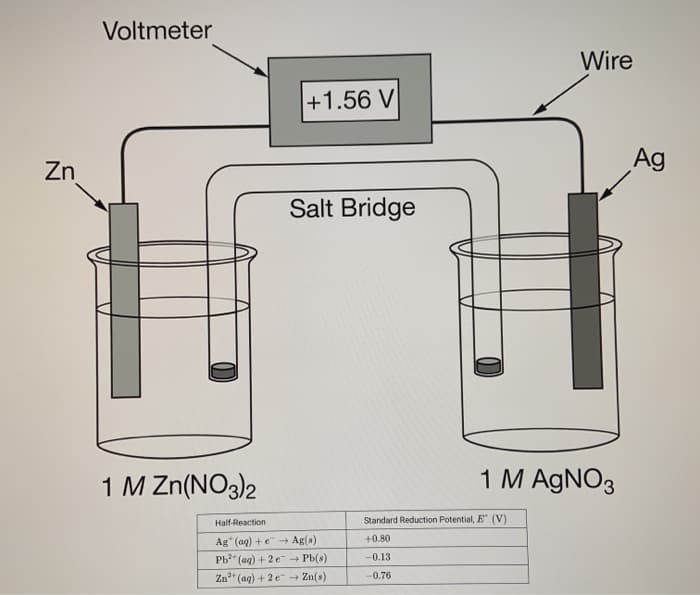The cell potential for the standard galvanic cell shown above is +1.56V. If AgNO3(aq)|Ag(s) is replaced with 1M Pb(NO3)2(aq) solution and a Pb electrode, which of the following describes what happens to the operation of the cell, and why? A. Nothing changes because galvanic cells that have a Zn(s) electrode have a constant cell potential, E°cell, of +1.56V. B. The cell stops generating a voltage because the standard reduction potentials of Pb2+ and Zn2+ are both negative. C. The cell potential decreases because the reduction of Pb2+ is less thermodynamically favorable than the reduction of Ag+. D. The cell potential increases because twice as many electrons are transferred between Pb2+ and Zn than between Ag+ and Zn.
The cell potential for the standard galvanic cell shown above is +1.56V. If AgNO3(aq)|Ag(s) is replaced with 1M Pb(NO3)2(aq) solution and a Pb electrode, which of the following describes what happens to the operation of the cell, and why? A. Nothing changes because galvanic cells that have a Zn(s) electrode have a constant cell potential, E°cell, of +1.56V. B. The cell stops generating a voltage because the standard reduction potentials of Pb2+ and Zn2+ are both negative. C. The cell potential decreases because the reduction of Pb2+ is less thermodynamically favorable than the reduction of Ag+. D. The cell potential increases because twice as many electrons are transferred between Pb2+ and Zn than between Ag+ and Zn.
Principles of Instrumental Analysis
7th Edition
ISBN:9781305577213
Author:Douglas A. Skoog, F. James Holler, Stanley R. Crouch
Publisher:Douglas A. Skoog, F. James Holler, Stanley R. Crouch
Chapter22: An Introduction To Electroanalytical Chemistry
Section: Chapter Questions
Problem 22.1QAP: Calculate the electrode potentials of the following half-cells. (a) Ag+(0.0436 M)|Ag (b) Fe3+ (5.34 ...
Related questions
Question
The cell potential for the standard galvanic cell shown above is +1.56V. If AgNO3(aq)|Ag(s) is replaced with 1M Pb(NO3)2(aq) solution and a Pb electrode, which of the following describes what happens to the operation of the cell, and why?
A. Nothing changes because galvanic cells that have a Zn(s) electrode have a constant cell potential, E°cell, of +1.56V.
B. The cell stops generating a voltage because the standard reduction potentials of Pb2+ and Zn2+ are both negative.
C. The cell potential decreases because the reduction of Pb2+ is less thermodynamically favorable than the reduction of Ag+.
D. The cell potential increases because twice as many electrons are transferred between Pb2+ and Zn than between Ag+ and Zn.

Transcribed Image Text:Voltmeter
Wire
+1.56 V
Ag
Zn
Salt Bridge
1 M Zn(NO3)2
1 M AgNO3
Half-Reaction
Standard Reduction Potential, E" (V)
Ag" (aq) +e Ag(s)
Ph* (ag) + 2e - Pb(s)
+0.80
-0.13
Zn" (ag) + 2 e→
Zn(s)
-0.76
Expert Solution
This question has been solved!
Explore an expertly crafted, step-by-step solution for a thorough understanding of key concepts.
This is a popular solution!
Trending now
This is a popular solution!
Step by step
Solved in 3 steps

Knowledge Booster
Learn more about
Need a deep-dive on the concept behind this application? Look no further. Learn more about this topic, chemistry and related others by exploring similar questions and additional content below.Recommended textbooks for you

Principles of Instrumental Analysis
Chemistry
ISBN:
9781305577213
Author:
Douglas A. Skoog, F. James Holler, Stanley R. Crouch
Publisher:
Cengage Learning



Principles of Instrumental Analysis
Chemistry
ISBN:
9781305577213
Author:
Douglas A. Skoog, F. James Holler, Stanley R. Crouch
Publisher:
Cengage Learning



Chemistry
Chemistry
ISBN:
9781305957404
Author:
Steven S. Zumdahl, Susan A. Zumdahl, Donald J. DeCoste
Publisher:
Cengage Learning

Chemistry: An Atoms First Approach
Chemistry
ISBN:
9781305079243
Author:
Steven S. Zumdahl, Susan A. Zumdahl
Publisher:
Cengage Learning

Chemistry: Principles and Practice
Chemistry
ISBN:
9780534420123
Author:
Daniel L. Reger, Scott R. Goode, David W. Ball, Edward Mercer
Publisher:
Cengage Learning